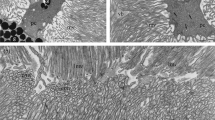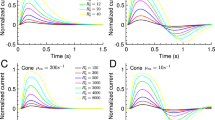Abstract
In order to test the hypothesis that excitation in Drosophila photoreceptors is mediated by Ca2+ released from internal stores, the Ca2+ buffers EGTA, BAPTA and di-bromo-BAPTA (DBB) were introduced into dissociated photoreceptors via whole-cell recording pipettes. All buffers were preloaded with Ca2+ to provide the same free Ca2+ concentration (250 nM). EGTA (up to 18 mM free buffer) had only weak effects upon voltage-clamped flash responses in normal Ringer's solution (1.5 mM Ca 2+0 ), and no effect in Ca2+-free solution. The maximum BAPTA concentration tested (14.4 mM free BAPTA) reduced the initial rate of rise by ca. 5000-fold in normal Ringer's solution; by ca. 500-fold in Ca2+free solution; and only ca. 60-fold in the absence of Mg2+, which preferentially blocks one component of the light-sensitive current. Although BAPTA delayed the time-to-peak in normal Ringer's solution, responses in Ca2+ free Ringer's solution were accelerated. These results support the role of Ca2+ influx in regulating sensitivity and response kinetics; however, in view of the high concentrations required to attenuate responses in Ca2+ free Ringer's solution, the role of Ca2+ release in excitation remains unclear. DBB was ca. 2–3 fold more potent than BAPTA, and at concentrations > 5 mM had a qualitatively different action, greatly delaying the time-to-peak. This suggests DBB may have distinct pharmacological actions or access to compartments inaccessible to BAPTA.
The only current activated by introducing 5–500 μM Ca2+ (buffered with nitrilo-triacetic acid) was electrogenic Na+/Ca2+ exchange. When this was blocked by removing Nao +0 , a novel cationic conductance was activated. However, its properties did not resemble those the light-activated conductance, and thus do not support the hypothesis that Ca2+ is sufficient for excitation.
Similar content being viewed by others
Abbreviations
- BAPTA :
-
bis-(o-aminophenoxy)-ethane-N,N,N′-tetracetic acid
- DBB :
-
Di-bromo-bapta
- NTA :
-
nitrilo-triacetic acid
- InsP 3 :
-
inositol 1,4,5-trisphosphate
References
Adler EM, Augustine GJ, Duffy SN, Charlton MP (1991) Alien intracellular calcium chelators attenuate neurotransmitter release at the squid giant synapse. J Neurosci 11: 1496–1507
Baumann O, Walz B (1989) Calcium and inositol polyphosphate-sensitivity of the calcium-sequestering endoplasmic reticulum in the photoreceptor cells of the honeybee drone. J Comp Physiol A 165: 627–636
Berridge MJ (1993) Inositol trisphosphate and calcium signalling. Nature 361: 315–325
Bloomquist BT, Shortridge RD, Schneuwly S, Pedrew N, Montell C, Steller H, Rubin G, Pak W (1988) Isolation of a putative phospholipase C gene of Drosophila norpA and its role in phototransduction. Cell 54: 723–733
Bolsover SR, Brown JE (1985) Calcium an intracellular messenger of light adaptation also participates in excitation of Limulus ventral photoreceptors. J Physiol (Lond) 364: 381–393
Brown JE, Rubin LJ, Ghalayini AJ, Tarver AP, Irvine RF, Berridge MJ, Anderson RE (1984) Myo-inositol polyphosphate may be a messenger for visual excitation in Limulus photoreceptors. Nature 311: 160–163
Fein A, Payne R, Corson DW, Berridge MJ, Irvine RF (1984) Photoreceptor excitation and adaptation by inositol 1,4,5-trisphosphate. Nature 311: 157–160
Frank TM, Fein A (1991) The role of the inositol phosphate cascade in visual excitation of invertebrate microvillar photoreceptors. J Gen Physiol 97: 697–723
Hardie RC (1991) Whole-cell recordings of the light induced current in dissociated Drosophila photoreceptors: Evidence for feedback by calcium permeating the light-sensitive channels. Proc R Soc Lond B 245: 203–210
Hardie RC (1995) Caged Ca2+facilitates and inactivates but does not directly excite light-sensitive channels in Drosophila photoreceptors. J Neurosci 15: 889–902
Hardie RC, Minke B (1992) The trp gene is essential for a light-activated Ca2+ channel in Drosophila photoreceptors. Neuron 8: 643–651
Hardie RC, Minke B (1993) Novel Ca2+ channels underlying transduction in Drosophila photoreceptor: implications for phosphoinositide mediated Ca2+ mobilization. Trends Neurosci 16: 371–376
Hardie RC, Minke B (1994a) Spontaneous activation of light-sensitive channels in Drosophila photoreceptors. J Gen Physiol 103: 389–407
Hardie RC, Minke B (1994b) Ca2+ dependent inactivation of lightsensitive channels in Drosophila photoreceptors. J Gen Physiol 103: 409–427
Hardie RC, Mojet MH (in press) Magnesium dependent block of the light-activated- and trp-dependent conductance in Drosophila photoreceptors J Neurophysiol (in press)
Hardie RC, Peretz E, Pollock JA, Minke B (1993a) Ca2+ limits the development of the light response in Drosophila photoreceptors. Proc R Soc Lond B 252: 223–229
Hardie RC, Peretz A, Suss-Toby E, Rom-Glas A, Bishop SM, Selinger Z, Minke B. (1993b) Protein kinase C is required for light adaptation in Drosophila photoreceptors. Nature 363: 634–637
Hochstrate P (1989) Lanthanum mimcks the trp photoreceptor mutant of Drosophila in the blowfly Calliphora. J. Comp Physiol A 166: 179–188
Hochstrate P, Juse A (1991) Intracellular free calcium concentration in the blowfly retina studied by Fura-2. Cell Calcium 12: 695–712
Kao JPY, Tsien RY (1988) Ca2+ binding kinetics of fura-2 and BAPTA from temperature-jump relaxation measurements. Biophys J. 53: 635–639
Lisman JE, Brown JE (1972) The effect of intracellular ionophoretic injection of calcium and sodium ions on the light response of Limulus ventral photoreceptors. J Gen Physiol 59: 701–719
Matsumoto E, Hirosawa K, Takagawa K, Hotta Y (1988) Structure of retinular cells in a Drosophila melanogaster visual mutant, rdgA, at early stages of degeneration. Cell Tissue Res 252: 293–300
Minke B, Selinger Z (1991) Inositol lipid pathway in fly photoreceptors, excitation, calcium mobilization and retinal degeneration. In: Osborne NN, Chader GJ (eds) Progress in retinal research, vol 11. Pergamon Press, Oxford, pp 99–124
Nagy K (1991) Biophysical processes in invertebrate photoreceptors: Recent progress and a critical overview based on Limulus photoreceptors. Q Rev Biophys 24: 165–226
Nagy K (1993) Cyclic nucleotides and inositol trisphosphate activate distinct components of the receptor current in Limulus ventral photoreceptors. Neurosci Lett 152: 1–4
Nagy K, Contzen K, Stieve H (1993) Two components of the receptor current are developed from distinct elementary signals in Limulus ventral nerve photoreceptor. Eur Biophys J 22: 341–350
Payne R, Fein A (1986) The initial responses of Limulus ventral photoreceptors to bright flashes. Released calcium as a synergist to excitation. J Gen Physiol 87: 243–269
Payne R, Howard J (1981) The response of an insect photoreceptor: a simple lognormal model. Nature 290: 415–416
Payne R, Walz B, Levy S, Fein A (1988) The localization of calcium release by inositol trisphosphate in Limulus photoreceptors and its control by negative feedback. Phil Trans R Soc Lond B 320: 359–379
Payne R, Flores TM, Fein A (1990) Feedback inhibition by calcium limits the release of calcium by inositol trisphosphate in Limulus ventral photoreceptors. Neuron 4: 547–555
Peretz A, Suss-Toby E, Rom-Glas A, Arnon A, Payne R, Minke B (1994) The light response of Drosophila photoreceptors is accompanied by an increase in cellular calcium: effects of specific mutations. Neuron 12: 1257–1267
Pollock JA, Assaf A, Peretz A, Nichols CD, Mojet MH, Hardie RC, Minke B (1995) TRP a protein essential for inositide-mediated Ca2+ influx is localized adjacent to the calcium stores in Drosophila photoreceptors. J Neurosci 15: 3747–3760
Putney JW Jr (1990) Capacitative calcium entry revisited. Cell Calcium 11: 6121–624
Rack M, Xhonneux-Crevers B, Shcraermeyer U, Stieve H (1994) On the Ca2+ dependence of inositol-phospholipid specific phospholipase C of microvillar photoreceptors from Sepia officinalis. Exp Eye Res 58: 659–664
Ranganathan R, Harris GL, Stevens CF, Zuker CS (1991) A Drosophila mutant defective in extracellular calcium-dependent photoreceptor deactivation and rapid desensitization. Nature 354: 230–232
Ranganathan R, Bacskai BJ, Tsien RY, Zuker CS (1994) Cytosolic calcium transients: spatial localization and role in Drosophila photoreceptor cell function. Neuron 13: 837–848
Ranganathan R, Malicki DM, Zuker CS (1995) Signal transduction in Drosophila photoreceptors. Ann Rev Neurosci 18: 283–317
Richardson A, Taylor CW (1993) Effects of Ca2+ chelators on purified inositol 1,4,5-trisphosphate (InsP3) receptors and InsP3 stimulated Ca2+ mobilization. J Biol Chem 268: 11528–11533
Roberts WM (1994) Localization of calcium signals by a mobile calcium buffer in frog saccular hair cells. J Neurosci 14: 3246–3262
Shin J, Richard EA, Lisman JE (1993) Ca2+ is an obligatory intermediate in the excitation cascade of Limulus photoreceptors. Neuron 11: 845–855
Smith DP, Ranganathan R, Hardy RW, Marx J, Tsuchida T, Zuker CS (1991) Photoreceptor deactivation and retinal degeneration mediated by a photoreceptor-specific protein kinase C. Science 254: 1478–1484
Smith PD, Liesegang GW, Berger RL, Czerlinski G, Podolsky RJ (1984) A stopped-flow investigation of calcium ion binding by ethylene glycol bis (β-aminoethyl ether)-N,N,-tetracetic acid. Anal Biochem 143: 188–195
Stieve H, Benner S (1992) The light-induced rise in cytosolic calcium starts later than the receptor current of the Limulus ventral photoreceptor. Vision Res 32: 403–416
Thomas MV (1982) Techniques in calcium research. Academic Press, London
Tsien RY (1980) New Calcium indicators in buffers with high selectivity against magnesium and protons: design, synthesis, and properties of prototype structures. Biochem 19: 2396–2404
Ukhanov KY, Flores TM, Hsiao HS, Mohaptra P, Pitts CH, Payne R (1995) Measurements of cytosolic Ca2+ concentration in Limulus ventral photoreceptors using fluorescent dyes. J Gen Physiol 105: 95–116
Walz B (1982) Calcium-sequestering smooth endoplasmic reticulum in retinula cells of the blowfly. J Ultrastruct Res 81: 240–248.
Walz B (1992) Enhancement of sensitivity in photoreceptors of the honey bee drone by light and by Ca2+. J Comp Physiol A 170: 605–613.
Author information
Authors and Affiliations
Rights and permissions
About this article
Cite this article
Hardie, R.C. Effects of intracellular Ca2+ chelation on the light response in Drosophila photoreceptors. J Comp Physiol A 177, 707–721 (1995). https://doi.org/10.1007/BF00187630
Accepted:
Issue Date:
DOI: https://doi.org/10.1007/BF00187630




